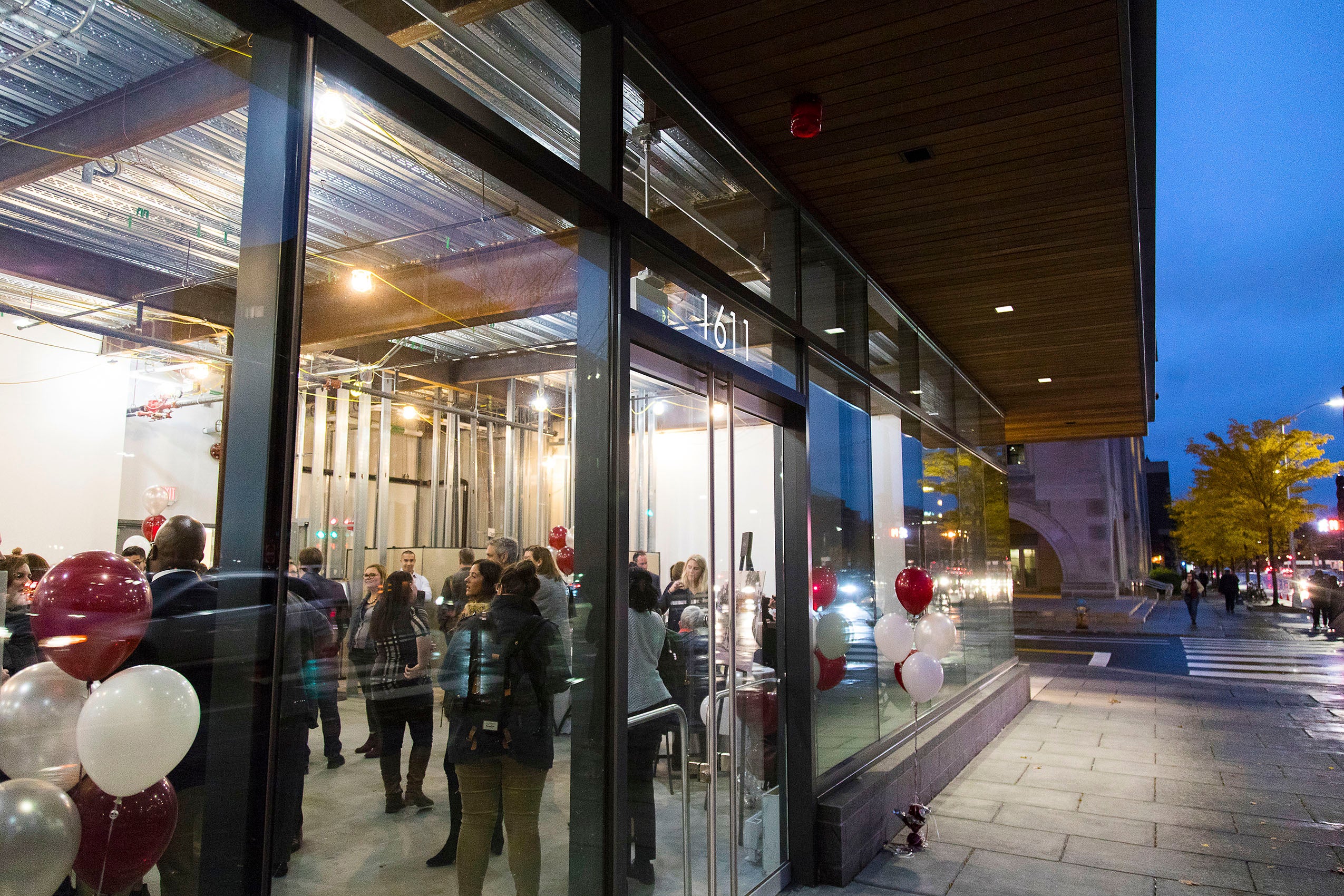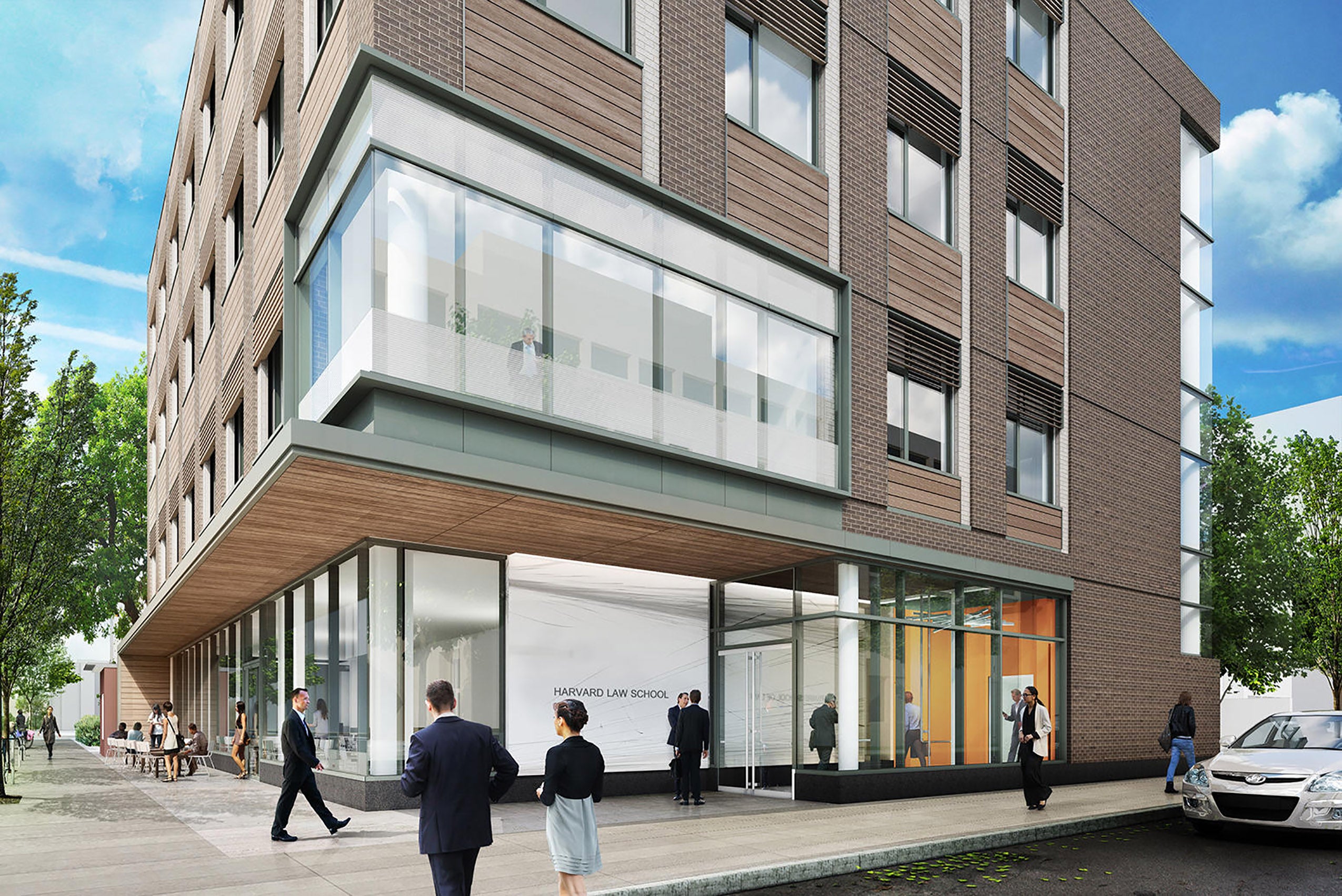Citing its future role in “innovation, deep learning, collegiality, and service,” Dean John F. Manning saluted the opening of the Harvard Law School’s newest building, at 1607 Massachusetts Avenue, on Monday evening. At a joyful reception in the open first floor, guests, faculty and community members nibbled pizza and sweets while taking in enlarged photos of the location’s previous incarnations, watching a time-lapse film of the structure’s 12 months of construction and queuing up for tours of the interior. Raising a glass of champagne, Manning thanked the many individuals from Harvard Law School and the City of Cambridge who had made the building possible, and he hailed the LEED Gold certified building as “designed to inspire and provoke collaboration.”
Indeed, the sleek wood and brick structure, which sits across Everett Street from HLS’s Wasserstein Hall, Caspersen Students Center, and Clinical Wing building, was created to foster and expand the law school’s experiential and clinical learning and to support research programs. Along with space for faculty offices and other future uses, 1607 Massachusetts Avenue, the first Harvard Law School project designed by Alex Krieger, a principal of NBBJ and professor at the Harvard Graduate School of Design, will provide elbow room for Harvard Law’s clinical education and research. It will serve as the new home for the Center for Health Law and Policy Innovation, which includes the Health Law and Policy Clinic and also the Food Law and Policy Clinic. The building will also house the Criminal Justice Institute and the Harvard Defenders, a clinical program and student practice organization, respectively, in which students represent clients in criminal hearings; the Islamic Legal Studies Program: Law and Social Change; the Animal Law & Policy Program; and the Access to Justice Lab.
“This new building reflects a commitment from both former Dean Martha Minow and our current dean to having a law school curriculum that reflects the needs of our law students and the community writ large,” said Clinical Professor Robert Greenwald, director of the Center for Health Law and Policy Innovation.
Clinical or experiential learning, Greenwald said, “needs a very different kind of space” than traditional lecture halls or classrooms. As an example, he described the new Health Law and Policy Clinic space, which features open areas, where students can work collaboratively, as well as more private offices and conference rooms. “A lot of the work happens via Skype and other electronic communication,” he said. “So all of our offices are designed for that.”

“The new building will provide invaluable space for the clinical programs and modern facilities to engage in the lawyering advocacy and teaching that are at the heart of the clinical programs,” said Clinical Professor of Law and Vice Dean for Experiential and Clinical Education Daniel L. Nagin. “This space will promote collaboration and enhance the ability of staff and students and faculty to interact and think across boundaries,” he added.
Chris Green, executive director of the Animal Law & Policy Program, is counting on it. “One of the main issues we focus on is factory farming, and there’s so much intersection there among issues of welfare, environmental harm, and food health and safety,” he said. “We’ve already collaborated with the Food Law and Policy clinic on several projects and now we’ll be one floor. We’re looking forward to this facilitating future collaborations.”
As well as encouraging interaction among its residents, explained Kreiger, the building is designed to be welcoming to the community. “There was a desire to make it part of the neighborhood,” said the architect. “As you walk by, it’s part of the fabric of Massachusetts Avenue.”

That is one reason, he noted, that the first floor of the new structure is open, glass-fronted retail space, presenting a welcoming face to the street. Like the site’s earlier incarnation, this space, which will be open to the general public, will continue a tradition of housing a particular food venue.
